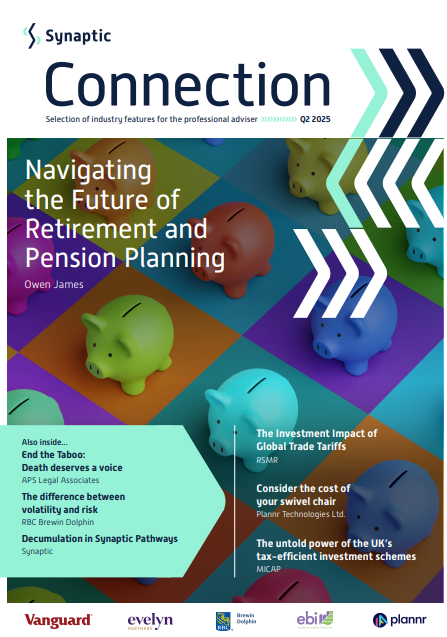In this edition...
- Navigating the Future of Retirement and Pension Planning: Key Insights for UK IFAs and Wealth Managers James Goad, Managing Director - Owen James
- Profit or Pitfall? The Investment Impact of Global Trade Tariffs Naeem Siddique, Investment Research Manager - RSMR
- Consider the cost of your swivel chair Abi Hortin, Marketing & Community Executive - Plannr Technologies Limited
- End the Taboo: Death deserves a voice Charlotte Merrills, Compliance & Associate Support Manager - APS Legal Associates
- From Calendar to Tolerance: Rethinking Portfolio Rebalancing Chris Johnston, MSc Data Analyst - ebi Portfolios
- The difference between volatility and risk Antony Champion, Managing Director - Head of Intermediaries - RBC Brewin Dolphin
- Billions in Innovation: The untold power of the UK’s tax-efficient investment schemes Prashant Trivedi, Investment Analyst - MICAP
- Decumulation in the Synaptic Pathways ecosystem Seb Marshall, Product Manager - Synaptic
- Market volatility is inevitable - Adviser’s Alpha® is enduring Warwick Bloore, Senior Specialist, Adviser Research Centre - Vanguard Europe
- Redefining Index Investment Strategies Dan Caps, Portfolio Manager - Evelyn Partners
- The FCA Protection Market study: What it means for intermediaries Kris Armstrong, Compliance Policy Manager - Simplybiz
 The US is the largest consumer market in the world, making it a critical target for global exporters. The Trump administration's recent decision to raise trade tariffs stems from a combination of economic, political, and national security objectives. These tariffs are part of a broader strategy aimed at reshaping the US' trade relationships and bolstering domestic industries but are not without high levels of controversy.
The US is the largest consumer market in the world, making it a critical target for global exporters. The Trump administration's recent decision to raise trade tariffs stems from a combination of economic, political, and national security objectives. These tariffs are part of a broader strategy aimed at reshaping the US' trade relationships and bolstering domestic industries but are not without high levels of controversy.
What is the Trump administration looking to achieve and is it achievable? If the US imports goods, it expects reciprocal purchases of American products, but this objective may be more idealistic than realistic, given entrenched global supply chains and the structural cost advantages held by other countries. Labour in Mexico is now cheaper than in China, but production hasn’t simply shifted south; China’s manufacturing dominance is built on decades of investment, deep supply chain integration, a vast skilled workforce, and operational expertise, and replicating that is no easy task.
What’s the state of play globally? Some countries seem relatively well-positioned - the UK is currently only subject to baseline tariffs which could present an opportunity for exporters seeking alternative markets for goods originally destined for the US, potentially offering a benefit to UK consumers. Despite initial fears of steeper penalties, Brazil is another unexpected beneficiary, potentially enabling Brazilian exporters to gain market share in the US, particularly in commodities - a sector where Brazil already holds a strong global position.
Some nations which are subject to more severe tariffs are attempting negotiations. A 90-day pause has been introduced, providing a window for discussion - but it’s not clear whether meaningful progress can realistically be achieved in such a short timeframe and there’s a risk that the situation could become even more disruptive once the deadline passes.
What about China? The US has now imposed a 145% tariff on Chinese imports. This move is part of a broader effort to pressure China over issues like intellectual property theft and forced technology transfers. In retaliation, China has raised tariffs on US goods to 125% and restricted exports of critical materials.
With tariffs of up to 25% placed on vehicle imports, auto manufacturers in South Korea and Japan - both major exporters – are also feeling the pressure. Even British automakers like Jaguar Land Rover have been affected. High-end models like the Range Rover will cost more but will this dampen demand or only enhance the vehicle’s status-symbol appeal?
What’s the story in Europe? Germany has unveiled a significant long-term investment plan, committing €500 billion over the next decade to bolster domestic growth. This initiative is expected to provide a notable boost to European GDP - potentially adding around 1% annually - and has been positively received by markets. Another area likely to see long-term gains is European defence. Fuelled by a renewed focus on regional security and self-reliance, companies in this sector across Germany, Italy, the UK, and broader Europe are showing strong performance.
"Currency dynamics are also in play. A weaker US dollar may support American exporters by improving the competitiveness of their goods abroad."
Meanwhile, currency dynamics are also in play. A weaker US dollar may support American exporters by improving the competitiveness of their goods abroad. Since many commodities are priced in dollars, a depreciation in the currency tends to drive commodity prices higher and real assets could emerge as key beneficiaries in such a scenario but there is a broader concern: could dollar weakness reflect a loss of global confidence in the currency as the world’s reserve standard?
What’s the outlook for investors? In the US, long-term yields have risen, reflecting expectations of increased debt issuance. Similarly, Europe - particularly Germany - may see pressure on bond markets as the new infrastructure fund gets underway and rising gold prices suggest ongoing investor demand for real assets in an uncertain climate. European equities have had a strong start to the year and could continue to offer a compelling haven, particularly if momentum in infrastructure and defence spending persists.
One thing is clear - the longer the current tariff uncertainty continues, the greater the negative impact on the global economy. The World Bank has already downgraded global growth projections once this year, and further revisions may be needed if the situation escalates. This is not just a US issue; unresolved trade tensions threaten to weigh on global growth overall.
From a market perspective, declining corporate earnings - even if they remain positive year-on-year - could still unsettle investors if growth slows, elevated US equity valuations may come under pressure, and companies with stretched valuations will be particularly vulnerable to any downward revisions.
What’s the likely outcome? A baseline 10% tariff appears increasingly likely to be imposed broadly, while China is expected to face much higher barriers. This leaves smaller exporting nations like Vietnam in a difficult position. They ship large volumes of consumer goods to the US, but their ability to balance trade by purchasing American products is limited, both in terms of need and availability.
Against this backdrop, 2025 could become a year defined by relative performance. Equity market returns may hinge on how markets fare relative to the US or regional peers rather than absolute strength.
Given the current volatility, many investors may find that staying the course is the most prudent approach. Attempting to time the market in such an unpredictable environment carries significant risk. Intra-day swings have been extreme - one morning’s losses can be reversed by afternoon rallies. In this kind of market, reacting too quickly may prove more costly than holding your nerve.
For more economic and market updates from RSMR and a whole host of impartial, forward-looking, qualitative investment research content, visit www.rsmr.co.uk.
Important information: This information is for UK Professional Advisers only and should not be given to retail clients. The value of investments and the income from them may go down as well as up and investors may not get back the amounts originally invested. Rayner Spencer Mills Research Limited is a limited company registered in England and Wales under Company Registration Number 5227656. Registered office: Number 20, Ryefield Business Park, Belton Road, Silsden, BD20 0EE. RSMR is a registered trademark.
Sign up for updates
Keep up to speed with everything you need to know each quarter, by email or post.


